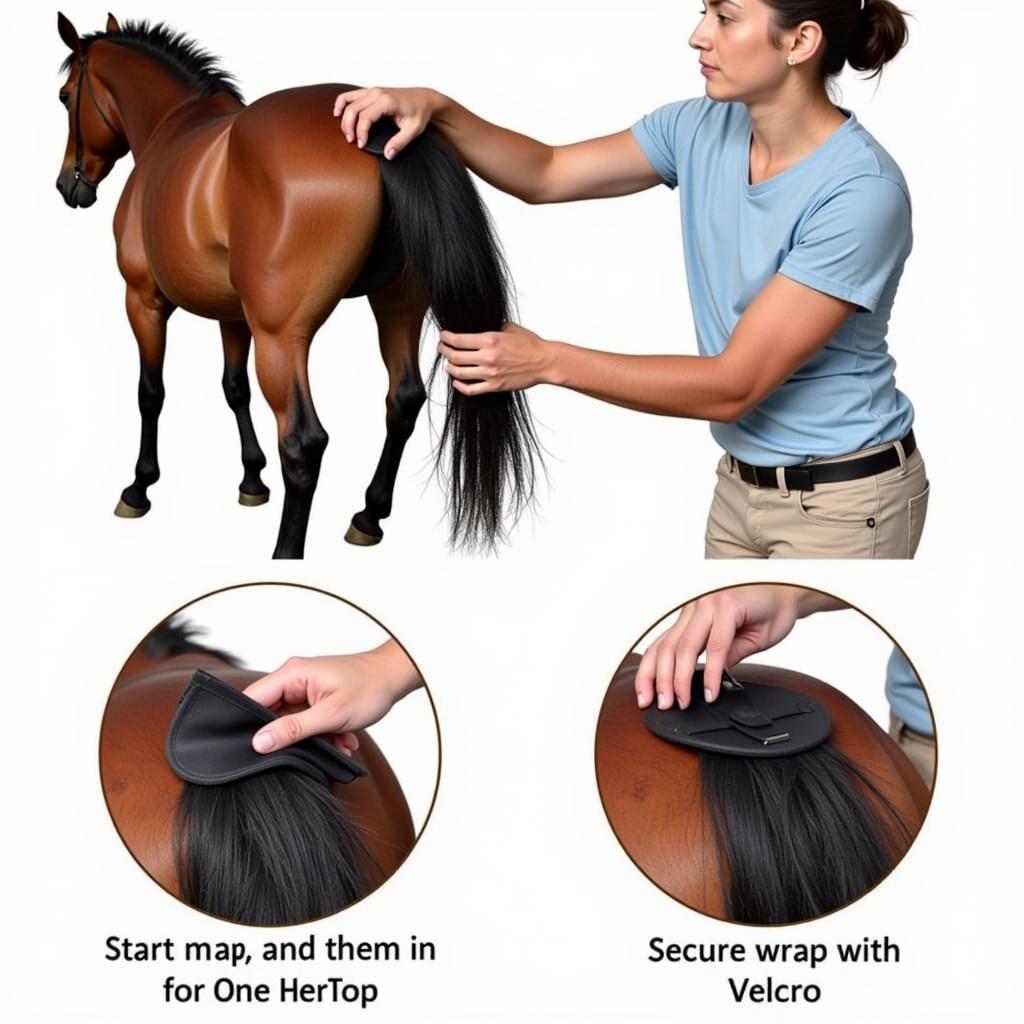Tail Wraps For Horses are essential pieces of equipment for any horse owner. Whether you’re protecting your horse’s tail during travel, preventing hair breakage, or adding a touch of style for competition, understanding the nuances of tail wraps is crucial. This guide will delve into everything you need to know about tail wraps, from choosing the right type to proper application and care.
Why Use Tail Wraps for Horses?
Tail wraps serve several vital purposes, making them a valuable addition to your horse care arsenal. They offer protection during transport, safeguarding the tail from rubbing and potential injury. Furthermore, tail wraps can prevent hair breakage and damage, especially for horses with long, flowing tails. This is particularly important for show horses, where a pristine tail is highly valued. Finally, certain types of tail wraps can add a touch of elegance and style, enhancing your horse’s overall appearance in competitions. For instance, a sleek, well-fitted tail wrap can complement the horse’s attire and add a professional touch.
Protecting your horse’s tail during shipping is of utmost importance. Consider investing in high-quality shipping boots horses to further ensure their safety and well-being during transportation.
Different Types of Tail Wraps
There’s a variety of tail wraps available, each designed for a specific purpose. Knowing the differences is key to choosing the right one for your horse’s needs.
Knitted Tail Wraps
Knitted tail wraps are a popular choice for everyday use and offer excellent breathability. They’re typically made from stretchy, comfortable material that conforms to the shape of the tail. They are also a great option for preventing tangles and keeping the tail neat and tidy.
Quilted or Padded Tail Wraps
Quilted tail wraps provide extra cushioning and protection, making them ideal for travel or for horses prone to rubbing their tails. The added padding helps to absorb impact and prevent chafing. These are also beneficial for horses recovering from tail injuries.
Lycra Tail Wraps
Lycra tail wraps are known for their sleek and stylish appearance, often used for showing or competition. They provide a smooth, polished look to the tail while still offering a degree of protection. These wraps are typically lightweight and breathable.
Protecting your horse from pesky insects is also crucial for their comfort and health. Explore effective fly protection for horses to ensure they remain undisturbed by flies and other biting insects.
How to Properly Apply a Tail Wrap
Proper application is crucial for both the effectiveness and comfort of the tail wrap. First, gently brush the tail to remove any tangles or debris. Then, starting at the top of the dock, carefully wrap the tail bandage downwards, ensuring even pressure and avoiding wrinkles.  Applying a Horse Tail Wrap Secure the wrap with Velcro or ties, making sure it’s snug but not too tight. It’s important to check the wrap regularly to ensure it hasn’t slipped or become too tight.
Applying a Horse Tail Wrap Secure the wrap with Velcro or ties, making sure it’s snug but not too tight. It’s important to check the wrap regularly to ensure it hasn’t slipped or become too tight.
Wondering what to offer your horse as a special treat? Discover some delightful options by exploring what do horses like to eat as a treat.
Caring for Your Horse’s Tail Wraps
Proper care will extend the life of your tail wraps. Most tail wraps are machine washable, but it’s always best to check the manufacturer’s instructions. Air drying is recommended to prevent shrinkage or damage to the fabric. Store your tail wraps in a clean, dry place to prevent mold or mildew.
Cavallos are known for their high quality and performance, so it is worth looking at cavallo boots for horses.
Choosing the Right Tail Wrap for Your Horse
Choosing the correct tail wrap depends on various factors such as the horse’s activity, tail length, and any specific needs. For everyday use, a knitted tail wrap offers breathability and tangle prevention. For transport or added protection, a quilted wrap is the best choice. And for showing, a lycra tail wrap provides a polished, professional look. Consulting with an equine veterinarian or experienced horse professional can help you make the best decision for your horse.
Vet wrap can be handy for various horse care needs. Learn more about vet wrap for horses and its applications in equine first aid and wound management.
Conclusion
Tail wraps for horses are an essential tool for any horse owner. By understanding the different types, proper application, and care, you can ensure the health and beauty of your horse’s tail. Selecting the right tail wrap and using it correctly contributes to your horse’s comfort, safety, and overall well-being.
FAQs
- How often should I change my horse’s tail wrap?
- Can I leave a tail wrap on overnight?
- What are the signs that a tail wrap is too tight?
- Are there specific tail wraps for different disciplines?
- How do I prevent a tail wrap from slipping?
- What materials are best for tail wraps in hot weather?
- Can I use a tail wrap on a horse with a sensitive skin?
If you need assistance, please contact us at Phone Number: 0772127271, Email: [email protected] or visit us at QGM2+WX2, Vị Trung, Vị Thuỷ, Hậu Giang, Việt Nam. We have a 24/7 customer service team.